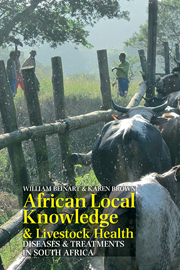Book contents
- Frontmatter
- Contents
- Acknowledgements
- Abbreviations
- Names of Common Diseases
- List of Maps, Photographs & Tables
- 1 Introduction: African Local Knowledge & Veterinary Pluralism
- 2 Ticks, Tick-borne Diseases & the Limits of Local Knowledge Introduction
- 3 ‘The Grave of the Cow is in the Stomach’: Environment & Nutrition in the Explanation & Prevention of Livestock Diseases
- 4 Transhumance, Animal Diseases & Environment
- 5 Plants & Drugs: Medicating Livestock
- 6 Medicinal Plants: Their Selection & their Properties
- 7 Animal Health & Ideas of the Supernatural
- 8 Gender, Space & the Supernatural
- 9 Conclusion
- Appendices
- Select Bibliography
- Index
4 - Transhumance, Animal Diseases & Environment
Published online by Cambridge University Press: 05 December 2013
- Frontmatter
- Contents
- Acknowledgements
- Abbreviations
- Names of Common Diseases
- List of Maps, Photographs & Tables
- 1 Introduction: African Local Knowledge & Veterinary Pluralism
- 2 Ticks, Tick-borne Diseases & the Limits of Local Knowledge Introduction
- 3 ‘The Grave of the Cow is in the Stomach’: Environment & Nutrition in the Explanation & Prevention of Livestock Diseases
- 4 Transhumance, Animal Diseases & Environment
- 5 Plants & Drugs: Medicating Livestock
- 6 Medicinal Plants: Their Selection & their Properties
- 7 Animal Health & Ideas of the Supernatural
- 8 Gender, Space & the Supernatural
- 9 Conclusion
- Appendices
- Select Bibliography
- Index
Summary
‘If they keep cattle right through the year here, they will die… the mud is killing the cattle.’
(Sidwell Caine, Mbotyi)The context of transhumance
Transhumance, or trekking in South African settler language, was intrinsic to white and black livestock management up to the early decades of the twentieth century. By transhumance, we mean the movement of people with livestock – a practice common to many societies, especially but not only in regions with large areas of pastureland held in common. The practice is not restricted to pastoralists, or those who specialise in livestock, and it takes a multitude of forms.
In the past, most African societies found it necessary to move their animals during the year, sometimes over considerable distances. Colonisation, private property and veterinary restrictions on movement made this increasingly difficult during the twentieth century. Yet the practice survives on a small scale in particular localities. This chapter explores the rationale and parameters of transhumance historically, and offers two examples of localised movement, in Mbotyi, Mpondoland, and QwaQwa. We suggest that transhumance in South Africa was shaped not least by the imperatives of animal nutrition and health, including the avoidance of specific animal diseases.
- Type
- Chapter
- Information
- African Local Knowledge and Livestock HealthDiseases and Treatments in South Africa, pp. 109 - 136Publisher: Boydell & BrewerPrint publication year: 2013



